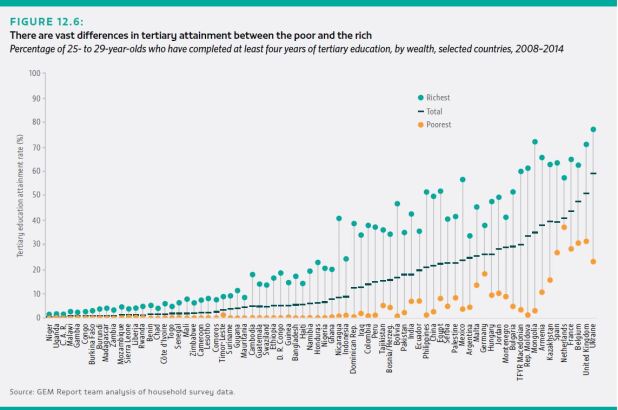 Last week, San Francisco, a city on the west coast of the United States, hit the news by announcing free tuition for all residents to the local public community college starting this fall.
Last week, San Francisco, a city on the west coast of the United States, hit the news by announcing free tuition for all residents to the local public community college starting this fall.
The offer is only available at one institution: the public community college in town, the City College of San Francisco. Free tuition will be accessible for all California residents living in San Francisco and taking courses for credit. The announcement comes on the heels of similar initiatives in Kentucky, Minnesota, Oregon and Tennessee and recent announcements in New York and Rhode Island.
“This is an investment in our youth, in our city and in our future,” said Mayor Ed Lee, “Education costs shouldn’t be a barrier to self-improvement. […] At a time when the political rhetoric is punishing those who are less fortunate, San Francisco has again united around our values and taken the national lead on this important issue of equality.”
We’re eliminating a major barrier #SF residents face by making #CCSF accessible to all our local residents https://t.co/JRXdW8whCA
— Mayor Ed Lee (@mayoredlee) February 6, 2017
The city has set aside $5.4 million for the initiative: $2.1 million will go to tuition and the rest will go straight to students to help with books, transportation, and other fees. Funds for the initiative come from a new transfer tax on properties selling for at least $5 million, approved by local voters last year. At $46 per credit, the pool of funds will cover around 45,000 credits, about 3,750 full time equivalent (FTE) students, just over half of the 6,400 FTE resident students enrolled in fall 2016. The initiative hopes to increase overall enrolments by 20% — enrolments recently plunged as the community college almost lost its accreditation due financial and governance mismanagement.
Several other states already have tuition-free programs in place, some of which were established following a proposal by the Obama administration . “Last dollar” statewide programs cover remaining tuition fees after other state and federal aid has been applied, with varying eligibility requirements. The plan announced by San Francisco on Monday has few restrictive conditions : It allows all residents to enroll, regardless of age, with no income eligibility requirements.
This story feeds into an enormously topical debate, one which the GEM Report will be exploring in its next policy paper out this spring: How can we improve access to affordable and quality tertiary education for all? Can free higher education be equitable and under what circumstances?
The last GEM Report looked at the disparities in access to and completion of higher education. Across 76 countries, 20% of the richest 25–29 year olds completed at least four years of tertiary education compared with less than 1% of the poorest.

Countries also differ in the extent to which households are covering the costs of higher education. In the United States, for example, almost half (46%) of tertiary education costs are covered by households. This proportion is beaten only by Japan (52%) and Chile (55%).
Across 26 countries in Europe, households contributed an average of 15% of total expenditure for tertiary education institutions in 2011, while student aid made up 18%. How these costs and subsidies are distributed varies considerably though. For example, Cyprus, Norway and the United Kingdom provided well over 40% of public tertiary education expenditure in the form of student aid. But while in Norway there are almost no fees and aid was used to compensate for differences in students’ ability to afford living costs during their studies, Cyprus and the United Kingdom used aid to offset the impact of high tertiary education fees.
Large household contributions do not necessarily mean that systems are unaffordable or not equitable. According to the OECD, Australia has more than twice the entry rate into bachelor’s programmes as Austria (76% vs. 34%), even though households contribute several times more to total tertiary education expenditure (40% vs. 2%). Australia has combined loans with income-contingent repayments and means-tested grants, encouraging disadvantaged students to enter tertiary education and reducing the risk of indebtedness. The precise mix of policy tools and their success in targeting those most in need are clearly critical, and should be monitored to understand how to facilitate affordability.
 Measuring the costs of higher education across different systems is not easy because there are so many variations to consider. Indeed, as the 2016 GEM Report pointed out, the proposed indicator framework to measure the education target 4.3 in the new SDG Agenda on higher education entirely ignores affordability – but progress towards this target in the next 15 years relies on it. Although debates on this issue are complex, we must identify a few basic parameters that will help ensure government policies on these types of education and learning opportunities are better targeted to those most in need.
Measuring the costs of higher education across different systems is not easy because there are so many variations to consider. Indeed, as the 2016 GEM Report pointed out, the proposed indicator framework to measure the education target 4.3 in the new SDG Agenda on higher education entirely ignores affordability – but progress towards this target in the next 15 years relies on it. Although debates on this issue are complex, we must identify a few basic parameters that will help ensure government policies on these types of education and learning opportunities are better targeted to those most in need.





Australia under a Labor government abolished all fees for tertiary education in the early 1970’s. However once the group who benefitted by this got into power they abolished free tertiary education and instituted a range of deferred debt repayment which is indexed twice per year so one is encouraged to pay off the debt sooner rather than later once the repayment threshold is reached or migrate to another country and default with little or no hope of the government recovering this money. So in a way tertiary education can still be free if the ethical and moral considerations are repositioned.
LikeLike